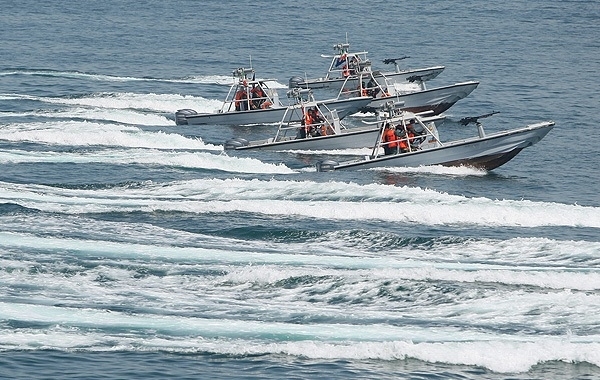
This post has been updated with an additional statement from U.S. 5th Fleet.
An Iranian admiral now says the country’s slow-down in sending small patrol boats to harass U.S. Navy ships in the Persian Gulf was spurred by what he describes as a change in U.S. behavior but doesn’t address the uptick in Iran’s drone flights in the region.
Rear Admiral Ali Ozmaei of the Iranian Revolutionary Guards said the U.S. Navy is now following international regulations and is avoiding approaching the Iranian coast, according to news reports.
Ozmaei’s comments came a week after U.S. Navy officials stated harassment from small Iranian patrol boats seems to have stopped in the congested Persian Gulf region, according to a story first reported by The Wall Street Journal.
U.S. Navy officials, though, told USNI News there has been no change to naval operations in the region.
“We are not going to speculate on the reason for this recent positive trend in interactions, though we hope it will continue in the future. The United States Navy has not adjusted its operations and will continue to operate wherever international law allows,” said statement from Cmdr. Bill Urban, U.S. Fifth Fleet spokesman.
“Even with the decreased incidents, we remain concerned with the increased number of Iranian UAVs operating in international airspace at night without navigation lights or an active transponder as would be expected according to international norms. We continue to advocate for all maritime forces to conform to international
maritime customs, standards and laws.”
Currently, the Theodore Roosevelt carrier strike group is operating in the region, as part of Operation Inherent Resolve. Led by USS Theodore Roosevelt (CVN-71), the strike group includes Carrier Air Wing 17, guided-missile destroyers USS Sampson (DDG-102), USS Preble (DDG-88), USS Halsey (DDG-97), and guided-missile cruiser USS Bunker Hill (CG-52).
Meanwhile, as the number of incidents involving small Iranian patrol boats approaching U.S. Navy ships has diminished, Iran appears determined to increase the number of unmanned drone aircraft sent to surveil U.S. Navy ships.
In recent months, Iranian QOM-1 Drones, also known as Shaheed 129, have been sent one or two times a day to fly over the Strait of Hormuz and the Southern Arabian Gulf, a U.S. official recently told USNI News. These drones often approach U.S. Navy ships operating in the region.
A week ago, Iranian navy officials claimed a drone chased away U.S. warships operating near an Iranian naval exercise. U.S. Navy officials quickly pushed-back against that claim, telling USNI News U.S. operations in the region were not affected by Iranian actions.
In August, on two different occasions, Iranian drones approached USS Nimitz (CVN-68) while the carrier conducted air operations in international waters.
The following is the complete January 31, 2018 statement to USNI News from Cmdr. Bill Urban, U.S. Fifth Fleet spokesman.
Over a period of 20 months, from January 2016 to August 2017, there
was an average of 2.5 unsafe and/or unprofessional interactions per month
between U.S. Navy and Iranian maritime forces. The last unsafe and
unprofessional interaction occurred on August 14, 2017, when an Iranian
unmanned aerial vehicle (UAV) without any navigation lights energized flew
in the vicinity of aircraft conducting night landing operations on the USS
Nimitz (CVN-68). In total, there were 14 unsafe and unprofessional
interactions in 2017 and 36 in 2016.
We are not going to speculate on the reason for this recent positive
trend in interactions, though we hope it will continue in the future. The
United States Navy has not adjusted its operations and will continue to
operate wherever international law allows. Even with the decreased
incidents, we remain concerned with the increased number of Iranian UAVs
operating in international airspace at night without navigation lights or an
active transponder as would be expected according to international norms. We
continue to advocate for all maritime forces to conform to international
maritime customs, standards and laws.
While we consider the decreased incidents in the second half of 2017
to be a positive development, the United States Navy remains vigilant as we
continue to operate.





